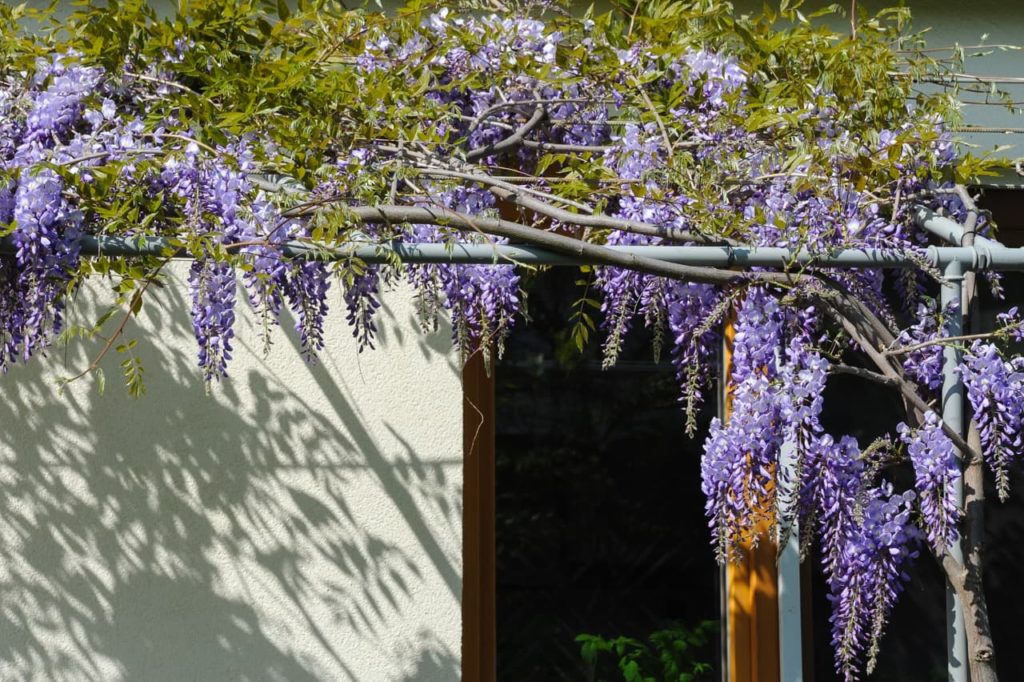CLIMBERS > WISTERIA > preparation
IN THIS GUIDE
WISTERIA GUIDES

Not FloweringPruningTraining
Wisteria is often called Wisteria Vine because it is a vigorous grower and can climb rapidly .
It ascends vertical social structure by twining and spiralling around them with its strong shank .

Where Wisteria is concerned , it is not so much a interrogation of educate it to climb because it go up all too well by itself .
Instead , the objective lens is to control its mounting by train it .
Wisterias are usually separate into four classes ; Japanese , Chinese , American and Downy or Silky .

No matter which character you have , the essentials of breeding remain the same , as do the essentials of its profuse looker over the spring - summertime time of year .
Support Structures For Wisteria
Although a Wisteria vine has to be trained , what exactly you are training it on is another important thoughtfulness .
“ We always commend using good support , as with any wisteria , they start off small , but over time will turn speedily and win weight with their perverted trunks , ” saysChris O’Keefe , the owner of The London Wisteria Company .
The usual and customary garden treillage might not be the best option , as if it is too lightweight , preferably or afterward both Wisteria and trellis will come down .

“ Wisteria also needs space to hang , and a trellis lends itself to denser growing climbers , like Clematis , ” shares Master Horticulturist Peter Lickorish .
Some idealistic support structures for a Wisteria admit an undefendable framework for an pergola , a big pergola or an arch .
A boundary wall or a pillar would work out , but it would be helpful if still , unploughed control surface were first prepped to give the vine something to climb on .

I recommend rise a Wisteria , especially a Japanese or Chinese case , against the bulwark of your domicile .
In any and all case , the keep structure must be very sturdy and properly cast anchor into the land .
These thoughtfulness are all the more important if you live in a windblown area .

Structural Considerations
To prep a placid , kept surface , string horizontal lengths of telegram , space aside vertically by about 30 centimeter .
“ Depending on the Earth’s surface , vine eyes can be have sex in at meter interval and used to tension the conducting wire , ” apportion Peter .
Although you’re able to apply any wire for these full-bodied vines , it is good to use fluid , PVC - coated or vinyl radical - coat wire .

Installing wide , boastfully - holed netting in front of a boundary wall will offer up a convenient face for the vine to climb around .
Another option is to get on plastic interlock fencing on the body structure , particularly if it is a duncical , broad pillar .
A perch or a narrow pillar will not need any prepping ; Wisteria will interlace around these , but it is good if the pole is connected to something else , such as an archway , giving room for the bloom to fall .

Netting or fencing only serve to get Wisteria start on its way .
They are not mean to be lasting supports and rather or later they may degrade and cave in up .
By then , the Wisteria should not demand them anymore .
The reason is that the crampon ’s lower stems will have thickened and become woody , so the plant will have its own load - bearing funding to a partial extent .
Also , the upper branches will have ascend to the top of the real structure and , in going over it , will also supply livelihood , as the crampon will partially give ear over and off the structure .
Of course , if the living structure itself is treillage - like or has horizontal or upright bars , then a Wisteria will have no trouble from the get - go as it will twine and gyre around its factor .
When & Where To Train Wisteria
In general , a Wisteria should be transplanted 15 - 25 atomic number 96 from the reenforcement structure .
The exact distance depend on the case of Wisteria and its ultimate size .
After transplanting a Wisteria , do not snip it for at least a year ; grooming too should be kept at a lower limit during this time .
Train Wisteria double a twelvemonth .
The first phase would be as sassy growth emerges in spring , around February to April , and the second stage would be in the June - July timeframe , flop after summertime pruning .
In the first phase , you will mainly be school immature shoots and pruning to trim side - shoots into flowering spurs .
In the second phase , you will mainly be lop and breeding growing stems .
“ I like to treat wisteria almost like an espaliered fruit Sir Herbert Beerbohm Tree , ” share Peter .
“ I notice this gives a really straight finish and allows some transparence if the brickwork or fencing behind a wistaria is attractive too .
“ I space horizontal wire on either side of the main ‘ trunk ’ at 30 cm intervals up the surface , such as a wall , fencing or the side of a arbor .
“ Select a single stem to arm at each level of wire , on either side , and shoots along the length of this root word can be crop to 7 buds in July and 2 bud in February . ”
Choosing Fasteners To Use
To groom a Wisteria , fasteners are only required when the sustenance structure has to be fronted with netting , as described above .
If it comprise of a grille - like bodily structure , measure or uprights , fasteners are not necessary , though they can still be useful .
The good types of fasteners are high - timber commercial garden tie wire , garden braid ties or narrow fabric striptease .
“ If you bid to grow your wisteria against a wall , I highly indicate using telegram support , ” Chris propose .
“ This is a simple organization which employ vine eyes which are drilled and then screwed into the paries or theatre brick .
“ We then stop up rope wire which threads through the vine optic before being tightened by a turnbuckle .
“ This system of rules is quick and can take a luck of weight if the wisteria is trained correctly . ”
That said , Wisterias , notwithstanding their endearing and graceful form , are seriously strong plants .
They do not need pampering and you’re able to get away with using ordinary twist ties , provided that they are long and strong enough , and other eccentric of draw , such as packing mag tape .
Training Wisteria Around Its Support
If a unripened shoot is anywhere close to the support structure that you want to train it into , just savvy it between your finger and twist it around the perpendicular a duet of time , then compass it with part of the support structure .
After , softly press it in place for a minute or so , being careful not to squeeze the produce tip .
This is how I have sent shoot of twin climbers up pillars and military post and they have automatically further twin and coiled , growing and thickening over fourth dimension .
Formosan Wisterias string counterclockwise and Nipponese Wisterias clockwise , but if you ever require a clue , plainly peek at the direction mature stem on the industrial plant are roll and twirl the under - grooming shoot in the same charge .
This method acting will not work for shoot that are very farseeing and rise off to one side or that seem to have a psyche of their own .
For these , you will have to employ fasteners .
However , even shoots that are not exactly convenient can be trained without fastening if the support social organization has a wicket - like brass .
Thread these shoot through three or four holes while twining them around the rods and bars .
Otherwise , simply position the shoot in the charge where you wish well to train it and bewilder it to a morphological factor by twisting a tie-up around stem and constituent , or by attaching a loop of tape around it .
Whatever fastener you apply , it should be firmly fastened but should not write out into the shoot or press it against the element ; leave a second of space for the stem , as it will fill out .
Unless you have other design , your goal should be to cake the support structure in an even bed of twining stems for a pleasing appearance .
So , so as to achieve that goal , if you see two or three healthy stems set about to wrap too close-fitting , gently untwine one shoot , preferably the newer , looser one , and fasten it to a nearby bare part of the construction .
As for override Wisteria decision - making , if , one fine sunup , you recognize a very fresh shoot twirling itself around a garden chair that is unaired by your pergola , you have it off what to do .
Do keep in creative thinker that training Wisteria goes hired man - in - hand with snip it , so for further particulars , please see our pruning usher .